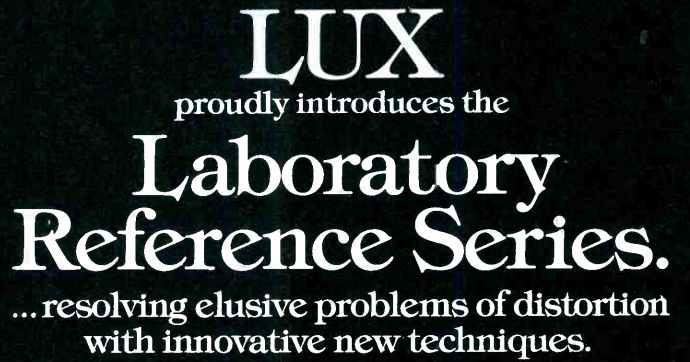
LUX proudly introduces the Laboratory Reference Series.
... resolving elusive problems of distortion with innovative new techniques.

Current and future LRS products are shown in this rack.
1) 5T50 frequency -synthesized digital stereo FM tuner, with Dolby and 7-station memory. $1,495.
2) 5C50 DC control preamplifier with linear equalizer, but without tone controls. $845.
3) 5G12 twelve -band stereo parametric graphic equalizer with switchable range and frequency contours. $645.
4) 5E24 LED peak indicator. $295.
5) 5M21 direct -coupled DC power amplifier: 100 watts per channel continuous power, with no more than 0.008 percent total harmonic distortion, both channels driven into 8 ohms, 20 to 20,000 Hz. Transient intermodulation distortion: 0.05 percent. $1,195.
Below the 5M21 are seen additional peak indicators and power amplifiers without meters. These amplifiers, a crossover network, switching facilities and tone controls are among future _RS products. All LRS models have metal enclosures designed for compact stacking. Optional vinyl -clad, wood -grain enclosures are also available.
The newly developed Laboratory Reference Series comprises a coordinated system of components whose performance characteristics represent a significant step forward in the state of the audio art.
Consider, for example, just two specifications of the direct-coupled DC power amplifier. At full rated power, intermodulation and total harmonic distortion are no more than 0.008 percent, a figure previously associated only with the finest preamplifiers.
Even more significant, the various sources of the elusive-but audibly crucial-transient intermodulation distortion (TIM) have been isolated and dealt with. As part of the LRS research program, LUX audiophile/engineers developed an innovative technique for precise measurement of TIM. With the LRS amplifier, it is 0.05 percent.
THD and IM distortion are conventionally measured with sine waves, which are inherently symmetrical and repetitive, unlike musical signals which are irregularly shaped, rapidly changing transients.
The large amounts of negative feedback normally used to reduce THD and IM distortion actually worsen TIM. Negative feedback involves returning a portion of the output signal--out-of-phase--to the input. When the signal is a sine wave, generated and measured by test instruments, this technique is effective.
However, with the constantly changing transients typical of music, the feedback signal returns to the input too late for the desired effect. It either "corrects" the wrong part of the waveshape or--far worse--fails to provide the instantaneous reduction of the signal required by the feedback-controlled circuits.
Result: the amplifier is driven into momentary clipping and overload -- the aspect of TIM that is most audible and disturbing.
A reduction of the feedback and signal transit time so that TIM distortion effects would be significantly reduced is precisely what LUX sought, and has now achieved, with the LRS amplifiers.
LRS vs. TIM.
Capacitors are necessary in conventional circuits to avoid bias -- upsetting DC. However, they slow the audio signal (appearing as phase -shift lags), particularly in the lower bass range. A new type of solid-state device developed for the LRS amplifier--a Dual Monolithic Linear Integrated Circuit has enabled LUX to eliminate all capacitors from the signal path.
The transistors commonly found in even the finest amplifiers are too slow (usually 4 microseconds) to cope adequately with transients. The recently developed (and very expensive) transistors in the LRS amplifier can switch in 0.5 microsecond.
Class B and Class A amplifiers have well-recognized limitations: Class B introducing 'crossover" distortion; Class A with power limitations and gross inefficiency. The LRS amplifier, is able to employ a bias point (in effect, Class AB) that achieves the best of both operating modes.
For more on LRS
All of the above are just high points of one LRS component, the Luxman 5M21 power amplifier, shown above with other current and future models.
We invite you to write for the new LRS literature. In the near future only a few audiophiles are likely to own these newest LUX achievements. But all can appreciate what they represent.
LUX Audio of America, Ltd. 200 Aerial Way, Syosset. New York 11791.
In Canada: White Electronics Development Corp., Ontario
(Source: Audio magazine, June 1977)
= = = =